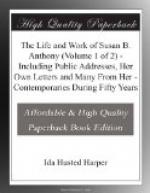Miss Anthony met her counsel at Albany, and on January 21 Judge Selden made a masterly argument before U.S. District-Judge N.K. Hall, in support of her demand for a writ of habeas corpus, and asked the discharge of the prisoner on the grounds: 1st, That in the act complained of she discharged a duty or, at all events, exercised a right, instead of committing a crime; that she had a constitutional and lawful right to offer her ballot and to have it received and counted; that she, as well as her brothers, was entitled to express her choice as to the persons who should make, and those who should execute the laws, inasmuch as she, as well as they, would be bound to observe them. 2d, That, if she had not that right, she in good faith believed that she had it and, therefore, her act lacked the indispensable ingredient of all crime, a corrupt intention.
The judge denied the writ and increased her bail to $1,000. From the first Miss Anthony had been determined not to recognize the right of the courts to interfere with her exercise of the franchise, and again she refused to give bail, insisting that rather than do this she preferred to go to jail. Judge Selden, however, in kindness of heart, said there were times when a client must be guided by advice of her counsel, and himself went on her bond. As she came out of the courtroom she met her other lawyer, Mr. Van Voorhis, and told him what had been done. He exclaimed, “You have lost your chance to get your case before the Supreme Court by writ of habeas corpus!” In her ignorance of legal forms she had not understood this, and at once she rushed back and tried to have the bond cancelled, but, to her bitter disappointment, this was impossible. When she demanded of Judge Selden, “Did you not know that you had estopped me from carrying my case to the Supreme Court?” he replied with his old-time courtesy, “Yes, but I could not see a lady I respected put in jail.”
The following day, January 22, the commission then in session at Albany for the purpose of revising the State Constitution was addressed by Miss Anthony on woman’s right to vote under the Constitution of the United States. Her attorneys, Selden and Van Voorhis, were present and, when she finished, the former said to her, “If I had heard this address first I could have made a far better argument before Judge Hall.” Immediately following the judge’s decision, Miss Anthony was indicted by the grand jury.[68]
During this winter she attended the Ohio and Illinois Suffrage conventions, and in a number of cities in these States and in Indiana made her great constitutional argument on the right of women to vote under the Fourteenth Amendment. Every newspaper in the country took up the points involved and the interest and agitation were wide-spread. She spoke at Ft. Wayne on February 25, an intensely cold night. Above her was an open scuttle, from which a stream of air poured down upon her head, and when half through her




